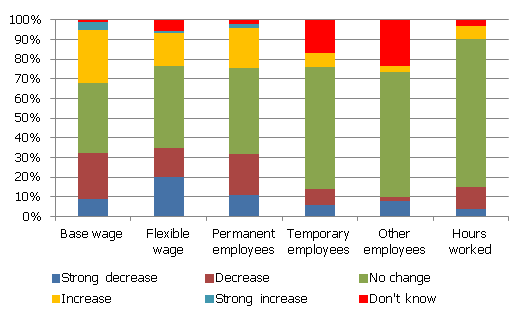Research: Latvia's 2008-2009 Wage Adjustment Stronger than Thought Before
For Latvijas Banka Monthly Newsletter, In Focus, Sepetmber
Our recent research [1] based on firm level data collected in Latvia within the framework of the Eurosystem's Wage Dynamics Network (WDN) shows much stronger wage adjustment during the 2008-2009 crisis than suggested by the macro data.
During the 2008-09 crisis, Latvia's gross domestic product (GDP) lost one fifth of its value, yet macro data reveal that the average wage in the private sector (including manufacturing) remained broadly flat, while competitiveness measured by unit labour costs was restored on the back of spectacular labour productivity rise. This apparent wage downward rigidity puzzled many international observers, including Olivier Blanchard [2] and Paul Krugman [3]. Yet the macroeconomic picture is likely to suffer from structural changes, particularly from labour hoarding of high-skilled employees, which may bias up the statistics of both average wage and productivity [4].
This research based on firm level data shows that wage adjustment was one of the main tools for firms to decrease total costs. About 33% of firms decreased wages of their employees during 2008-2009. Base wages or piece work rates were as likely to be reduced as flexible wage components (see Chart), reflecting low collective bargaining coverage and over-optimistic wage growth prior to 2008. Wage cuts were particularly widespread in 2009 when a strong demand slowdown created the necessity to decrease labour costs significantly. Wage freezes, meanwhile, were mostly used in 2010 and 2011. In 2012 and 2013, in line with robust economic growth, the prevalence of wage cuts and freezes decreased markedly.
Wage freezes and cuts were applied relatively more by large firms. For instance, in 2009, 39% of employees working in large firms experienced a wage cut, while wages of other 20% of employees were frozen (twice as much as in small firms). The analysis of marginal effects from ordered logistic regressions shows that the elasticity of wage freeze to firm size increased with time, whereas the elasticity of wage cut to firm size declined.
If a firm had implemented the wage freeze strategy, wages of about 90% of employees were frozen on average. Meanwhile, the implementation of wage cut strategy affected 60% of employees on average. If a firm decreased the wage of a particular employee, the average decrease varied from 16% to 26% in different years. Small firms tended to decrease wages more sharply and for a larger share of employees.
It is noteworthy that before 2012, firms facing a strong decrease in demand were as likely to implement wage cuts and freezes as firms facing a strong increase in demand. It means that during the crisis some firms took advantage of the overall tendency to decrease wages and reduced labour costs despite favourable demand conditions. In later years, however, the situation changed significantly: in firms with a strong demand increase wage cuts were not implemented at all.
Overall, the analysis of firm level data suggests that wage adjustment in Latvia during 2008-2009 was much stronger than the macro data suggest.
Chart. Change in labour cost components during 2008-2009 (% of employees)

[1] FADEJEVA, Ludmila, KRASNOPJOROVS, Olegs (2015) - Labour Market Adjustment During 2008-2013 in Latvia: Firm Level Evidence. Bank of Latvia Working Paper (forthcoming)
[2] BLANCHARD, Olivier, GRIIFITHS, Mark, GRUSS, Bertrand (2013) - Boom, Bust, Recovery: Forensics of the Latvia crisis. Brooking Papers on Economic Activity, Fall 2013. Available: http://www.brookings.edu [cited 09.2015]
[3] KRUGMAN, Paul (2013) - Latvian Adventures. The New York Times. Available: http://krugman.blogs.nytimes.com [cited 09.2015]
[4] KRASNOPJOROVS, Olegs (2011) – Average Wages in Latvia: How Big, How Credible, How Relevant They Are. Macroeconomics.lv, Latvijas Banka. Available: https://www.macroeconomics.lv [cited 09.2015]
Textual error
«… …»







